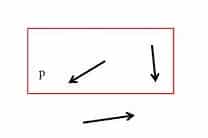NON-COPLANAR VECTORS
Vector is a concept with several meanings. If we focus on the field of physics , we find that a vector is a quantity defined by its sense, its direction, its quantity and its point of application.

The adjective coplanar , for its part, is used to describe lines or figures that are in the same plane . It is important to mention, however, that the term is not correct from a grammatical point of view and, therefore, does not appear in the dictionary produced by the Royal Spanish Academy ( RAE ). This entity mentions, instead, the word coplanar .
The vectors that are part of the same plane, in this way, are coplanar vectors . In contrast, vectors that belong to different planes are called non-coplanar vectors .
It is established, therefore, that non-coplanar vectors, as they are not in the same plane, it is essential to go to three axes, to a three-dimensional representation, to expose them.
To find out whether the vectors are coplanar or non-coplanar, it is possible to use the operation known as the mixed product or the triple dot product . If the result of the mixed product is different from 0 , the vectors are non-coplanar (the same as the joining points ).
Following the same reasoning, we can affirm that when the result of the triple scalar product is equal to 0 , the vectors in question are coplanar (they are in the same plane).
Take the case of vectors A (1, 2, 1) , B (2, 1, 1) and C (2, 2, 1) . If we perform the triple dot product operation, we will see that the result is 1 . Being different from 0 , we are in a position to maintain that they are non-coplanar vectors .
It is also important to know, when working and studying vectors, be they non-coplanar or of any other type, that they have four fundamental characteristics or signs of identity. We are referring to the following:
-The module, which is the size of the vector in question. To determine it, it is necessary to start from what is its extreme and the point of application.
-The meaning, which can be of very different types: up, down, horizontal to the right or left ... It comes to be determined, as is logical, based on the arrow at one of its ends.
-The point of application, already mentioned above, which is the origin from which the vector works.
-The direction, which is the orientation acquired by the line in which the vector in question is located. In this case, we can determine that this direction can be horizontal, oblique or vertical.
In many scientific and mathematical areas, these vectors, coplanar and non-coplanar, are used, but also many others that exist. We are referring to the concurrent, the collinear, the unitary, the angular, the free ...
With any of these, operations such as sums or even products can be carried out, which will be undertaken using the different existing methods and procedures.
Comments
Post a Comment